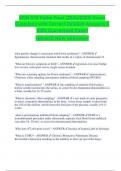MSN 570 Patho Final (2024/2025) Exam
Questions with Correct Detailed Answers ||
100% Guaranteed Pass!!
<BRAND NEW VERSION>
what genetic change is associated with Down syndrome? - ANSWER ✔
Spontaneous chromosomal mutation that results in 3 copies of chromosome 21
What are Down's symptoms at birth? - ANSWER ✔ hypotonia, low nose bridge,
low set ears, with spots on iris, single crease in palms
What are screening options for Down syndrome? - ANSWER ✔ amniocentesis,
Chorionic villus smapling, percutaneus umbilical blood sampling (PUUBS)
What is amniocentesis? - ANSWER ✔ the sampling of amniotic fluid using a
hollow needle inserted into the uterus, to screen for developmental abnormalities in
a fetus. usually bet 14-15 weeks
What is chorionic villus sampling? - ANSWER ✔ a test made in early pregnancy
to detect congenital abnormalities in the fetus. A tiny tissue sample is taken from
the villi of the chorion, which forms the fetal part of the placenta. usually at 9-11
weeks
what is percutaneous umbilical blood sampling? - ANSWER ✔ PUBS is a
transabdominal procedure under ultrasound; aspirates fetal blood from umbilical
vein after 18- 20 wks'. to assess for chromosomal abnormalities
Why does ST elevation occur? - ANSWER ✔ because of hypoxia due to blockage
What is COPD? - ANSWER ✔ Chronic Obstructive Pulmonary Disease.
Irreversible obstruction resulting in the inability to force air out of the lungs.
, what causes COPD? - ANSWER ✔ smoking that l/t inflammatory response and
causes damage to lung.
How does chronic bronchitis and emphysema contribute to COPD? - ANSWER ✔
Chronic bronchitis is chronic inflammation of bronchi (large airway) while
emphysema results from continue exposure to poultans that damage small airways,
alveolus.
what are restrictive pulmonary disorders - ANSWER ✔ ARDS, Atelectasis
What are obstructive pulmonary disorders? - ANSWER ✔ asthma, COPD, Sleep
Apnea, Cystic fibrosis
Define total lung capacity (TLC) - ANSWER ✔ volume of air in the lungs after a
maximum inhalation
Define FEV1 and tell its clinical significance. - ANSWER ✔ FEV1 = volume of
air exhaled during first second of forced expiratory volume (amount of air expelled
during specific times of FVC test)
Define FVC (Forced Vital Capacity) - ANSWER ✔ Measure amount of gas
expelled when patient takes deep breath in and exhales as forcefully and rapidly as
possible
-Healthy person: 80%, restrictive disease: 80% or more, obstructive disease: less
than 80%
What is cystic fibrosis? - ANSWER ✔ It is a genetic disorder of the cell
membranes. Causes thick, sticky mucus to build up in air passages and pancreas.
Why does PO2 drops in COPD? - ANSWER ✔ PO2 drops because there is
decrease oxygenation occurring due to damaged alveoli
Why is O2 sat decreased in COPD patients? - ANSWER ✔ O2 sat is decreased in
COPD patients because there is inadequate oxygenation to tissues
secondary intention - ANSWER ✔ Wound closure in which the edges are
separated; granulation tissue develops to fill the gap; and, finally, epithelium grows
in over the granulation, producing a larger scar than results with primary intention.
, 4 stages of wound healing - ANSWER ✔ hemostasis, inflammation, proliferation,
remodeling
coagulation cascade - ANSWER ✔ exposed collagen + tissue factor
platelets bind collagen + fibrin stbz via thrombin
--> clot
granuloma - ANSWER ✔ a general term used to describe a small, knot-like
swelling of granulation tissue in the epidermis
graft versus host disease - ANSWER ✔ T cells in a transplanted graft are capable
of a cell-mediated response against the unmatched histocompatibility antigens on
the tissue of the graft recipient
Graves disease - ANSWER ✔ an autoimmune disorder that is caused by
hyperthyroidism and is characterized by goiter and/or exophthalmos
Hashimoto's disease - ANSWER ✔ an autoimmune disease in which the body's
own antibodies attack and destroy the cells of the thyroid gland
Hürthle cells - ANSWER ✔ Hashimoto thyroiditis
grave's disease levels - ANSWER ✔ TSH levels to be low while the T3 and T4
levels to be high
hyperthyroidism - ANSWER ✔ low TSH with a high T3 and T4
gas gangrene - ANSWER ✔ Necrosis in a wound infected by an anaerobic gas
forming bacillus, the most common etiologic agent being Clostridium perfringens.
wet gangrene - ANSWER ✔ an area of gangrene that becomes secondarily
infected by pus-producing bacteria
necrosis - ANSWER ✔ tissue death
apoptosis - ANSWER ✔ programmed cell death
, prothrombin time (PT) test measures - ANSWER ✔ deficiencies in factors II, V,
VI, and X, and the functioning of the common and extrinsic coagulation pathways
activated partial prothrombin time (aPTT) test - ANSWER ✔ evaluates
coagulation using a reagent containing calcium chloride and phospholipids to
stimulate platelet-deficient plasma. frequently used in clinical settings to evaluate
patient response to unfractionated heparin medication, achieve therapeutic
anticoagulation, and aid in diagnosing bleeding or clotting abnormalities.
D-dimer - ANSWER ✔ unique fragment that is produced when cross-linked fibrin
breaks down
additional condition that can initiate DIC - ANSWER ✔ Acute fatty liver,
amniotic fluid embolism, retained stillbirth, sepsis, HELLP syndrome,
preeclampsia, and postpartum hemorrhage
Acute Lymphoblastic Leukemia - ANSWER ✔ Leukemia which arises during
childhood and has a 90% cure rate in that age group
Acute Lymphoblastic Leukemia labs - ANSWER ✔ low red blood cell count
(anemia), low platelet count (thrombocytopenia), and elevated white blood cell
count
acute lymphoblastic leukemia three key tests - ANSWER ✔ BLOOD SMEAR
high number of immature white blood cells,
BONE MARROW ASPIRATION/BIOPSY high percentage of lymphoblasts
CYTOGENETIC TESTING Genetic testing was performed to determine specific
chromosomal abnormalities
AML acute myeloid leukemia - ANSWER ✔ myeloid cells responsible for
generating red blood cells, platelets, and specific white blood cells
acute lymphoblastic leukemia signs and symptoms - ANSWER ✔ vEasy bruising
or bleeding, especially gums
vFatigue/ Fever
vBone pain
vFrequent infections
vWeight loss




